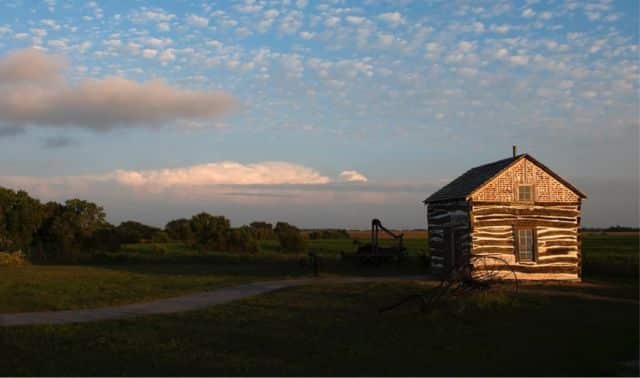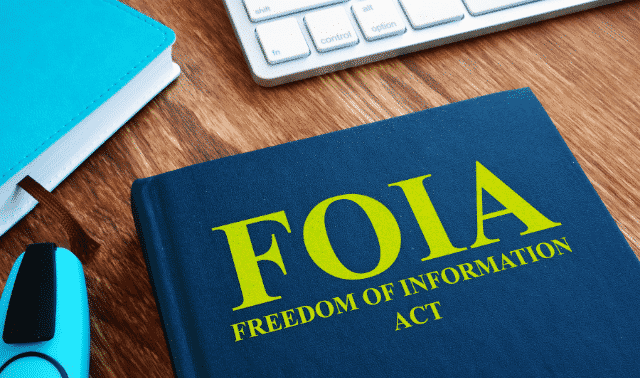
If you’ve ever suspected the US government is keeping files on you, you’re not being paranoid. Uncle Sam has reams of paperwork on most Americans—and not just us modern folks, but also our ancestors. The bad news is that the tax man knows who you are and where you live.
But on the bright side, when you’ve hit a genealogy brick wall— particularly in the 20th century—tapping government sources such as Social Security applications, naturalization records and FBI files can lead to the breakthrough you need.
Accessing many federal records requires filing a Freedom of Information Act (FOIA) request, which isn’t as scary as it sounds. Though you may associate FOIA requests with investigative reporters, ordinary folks—not just the heirs of Bob Woodward and Carl Bernstein—file the vast majority of them. Some records don’t call for FOIA requests, but require you to jump through other hoops.
But don’t be intimidated by Uncle Sam’s bureaucracy: Our guide to federal records will get you through the red tape stuck to your ancestors’ files.
Privacy Rules for Government Records
In general, FOIA applies to agencies of the executive branch of government—from the Social Security Administration to the Department of Labor. Enacted in 1966 and revised in 1996, it gives citizens access to government documents of all sorts. Documents about the supervision of financial institutions and geological information on wells are exempt, but that’s not likely to impede your research.
You may run into the Privacy Act of 1974, which protects paperwork such as your income-tax records and student-loan files from prying eyes. The Privacy Act also guarantees your right to view government documents about yourself. Does the FBI have a file on you because of that unfortunate incident in college when you had a little too much to drink? The Privacy Act lets you find out.
But this law also protects your ancestors’ privacy. Generally, record requests require either that the person whose record it is was born more than 100 years ago or that you provide proof of death. Acceptable proof might be a copy of a death certificate (uncertified is OK), printed obituary, funeral program, gravestone photo, church record, evidence of payment of death benefits, or an individual Social Security Death Index (SSDI) record.
Otherwise, an FOIA request typically requires nothing more than writing a letter to the appropriate government agency; check out the examples on this page under Sample Letters. Fees are usually modest, and many FOIA requests won’t cost you anything at all.
Some government records about individuals no longer require a FOIA request—notably, naturalization and alien-registration files from US Citizenship and Immigration Services (USCIS, formerly the Immigration and Naturalization Service, or INS), which launched a genealogy program in August 2008. And of course, most of the records in Uncle Sam’s primary filing cabinet, the National Archives and Records Administration (NARA), are open to the public.
Social Security Records
Records of the Social Security Administration are probably the genealogical files most often sought under the FOIA. You’re already familiar with the Social Security Death Index (SSDI), which you can search for free several places online, including FamilySearch and RootsWeb. Numbering nearly 84 million names, the SSDI contains information on people whose death was reported to the agency, typically by a dependent claiming a death benefit. Because the records weren’t computerized until 1962, 98 percent of deaths listed in the SSDI happened that year or later.
Although the SSDI is a handy tool, keep in mind that the Social Security Administration is a relatively recent creation, and wasn’t originally as all-encompassing as it is today.
Established in 1935, the agency started keeping records in November 1936. Initially, only people who worked outside the home needed a Social Security card, so many housewives and older people never registered. Until 1951, the system didn’t cover the self-employed, temporary government workers, farmers and other agricultural laborers, domestic workers such as maids, workers in US territories or overseas employees of American companies. Self-employed lawyers, dentists, medical professionals (except physicians) and other professionals came under the Social Security umbrella in 1956; MDs didn’t get coverage until 1965. Employees of nonprofits were excluded in 1951 but added back in 1984, along with federal workers hired after Jan. 1, 1984. Only in 1988 were all children required to have Social Security numbers.
Long-term railroad workers were covered separately under the Railroad Retirement Board, though they did receive Social Security numbers and about 430,000 of them are included in the SSDI. Prior to June 1963, railroad employees were assigned special Social Security numbers, beginning with digits between 700 and 728. The board will search for genealogical information in its files for a nonrefundable fee; write:
Railroad Retirement Board
844 N. Rush St.
Chicago, IL 60611
Other Social Security numbers contain clues, too. Prior to 1972, the first three digits, called the Area Number, indicated where the card was issued, generally beginning in the Northeast and moving west: 001 to 003 was New Hampshire; Hawaii got 575 and 576. A list of numbers by state can be found in RootsWeb’s SSDI guide. The second set of two digits, the Group Number, was a control against fraud, issued in alternating odd/even groupings rather than in numerical order like the final four digits, the Serial Number.
Even if you can’t find an ancestor in the SSDI and don’t know the Social Security number, you still can request a copy of his or her Social Security Number Application (SS-5), if there is one. You can complete the process and pay by credit card online. Or you can mail your request as a letter or on form SSA-711 (PDF download) to:
Social Security Administration
SSA OEIO DEBS FOIA
Box 33022
Baltimore, MD 21290
Provide as much information about your ancestor as you can. You don’t have to submit proof that the person is deceased (generally, the agency knows that). But if you’re writing a letter, it’s a good idea to mention this. Enclose a check or money order, or use form SSA-714 if you pay by credit card. Write “FREEDOM OF INFORMATION REQUEST” on both the envelope and its contents.
FOIA requests are supposed to be handled within a few weeks, though a backlog can cause a delay. When you do receive your ancestor’s application, it’ll probably contain a wealth of details: full name, address, place of employment, age, date and place of birth, and full name of each parent including mother’s maiden name. Applications from older individuals, primarily those born in 1910 or before, may not contain all this data.
Immigration Records
Inquiries for genealogy information from USCIS have been so popular that the agency started its own Genealogy Program, which doesn’t require an FOIA request.
The fee-for-service program covers two types of requests. Typically you’ll start with an Index Search ($65), in which the USCIS combs through its historical immigration and naturalization indexes for citations about an immigrant. You can then use the resulting “record citations”—USCIS file numbers—to request copies of records. This Record Copy Request costs $65.
If you already know the file number from an ancestor’s paperwork you’ve found elsewhere, you can skip the Index Search step and go straight to the Record Copy Request. You can order an index search or record copies online (pay by credit card) or by mail (send a money order or cashier’s check).
For an Index Search, provide as much information about the immigrant ancestor as possible. First and last name, country and date of birth are required, though you can estimate the birth date. If an ancestor’s date of birth is less than 100 years ago, you must provide proof of death. You’ll be able to add optional details, such as arrival date and place of residence in the United States, that’ll help USCIS fill your request. You can upload your evidence as scanned documents in JPG, GIF, PDF or Word format, or mail copies (not originals—you won’t get them back).
The USCIS was swamped when the Genealogy Program launched, but now strives to respond to inquiries within 90 days.
Five kinds of records are available through the USCIS genealogy program, each potentially rich with family history:
- Naturalization certificate files (C-Files) dating Sept. 27, 1906, to March 31, 1956: Prior to the 1906 Naturalization Act, the process of becoming a citizen—along with the resulting paperwork—was the domain of courts, mostly local ones. After Sept. 27, 1906, copies of all US naturalization records were filed in Washington, DC. Many of these C-Files contain documents such as correspondence, affidavits or other records, and many from 1929 on include photos.
- Alien registration forms (Form AR-2), dating August 1940 to March 31, 1944: The Smith Act, passed amid rising concerns about US entry into World War II, required non-citizens in the United States age 14 or older to register as aliens. Some 5.5 million resident or arriving aliens—many who subsequently became naturalized citizens—completed Form AR-2. The two-page form was practically a full biography: name; name at arrival; other names used; address; post office address; date and place of birth; sex; marital status; race; height; weight; hair and eye color; date, place, vessel and class of admission of last US arrival; date of first arrival; number of years in the United States; occupation; name, address and business of present employer; membership in clubs and organizations; dates and nature of military or naval service; whether citizenship papers had been filed, and if so, the date, place and court for declaration or petition; number of relatives living in the United States; arrest record, including date, place and disposition of each arrest and whether or not affiliated with a foreign government. (Whew.)
- Visa files dating July 1, 1924, to March 31, 1944: These are arrival records of immigrants admitted for permanent residence under the Immigration Act of 1924. They contain information normally found on a ship passenger list, plus the immigrant’s places of residence for five years prior to emigration, names of parents and more. Birth records or affidavits are usually attached; sometimes marriage, military or police records are, too.
- Registry files dating March 2, 1929, to March 31, 1944: When no passenger arrival record could be found for someone who’d entered the country prior to July 1, 1924, citizenship officials would set up a registry file with documents supporting the immigrant’s claims of arrival and residence. This may include proof of residence, receipts and employment records.
- Immigrant files (A-Files) dating April 1, 1944, to May 1, 1951: These alien case files became the official file for immigration records created or consolidated since April 1, 1944. Only A-File documents dated to May 1, 1951, are available under the Genealogy Program. Most A-files for immigrants born more than 100 years ago are being transferred to NARA’s Kansas City location. However, A-files for INS district offices from western districts like San Francisco and Honolulu are at the San Francisco branch. For other A-files housed in Kansas City, send requests to:
National Archives at Kansas City
Attn: A-Files Request
400 W. Pershing Road
Kansas City, MO 64108
You can request files not covered by the Genealogy Program using FOIA. For naturalizations on or after April 1, 1956, visa files for immigrant arrivals after March 31, 1944, and Border Patrol records, write:
Military Personnel Records
Earlier immigration records, as you probably know, reside at NARA, where they and most other records of genealogical interest—because of their age—can be accessed without an FOIA request.
Military and veterans’ records, also at NARA, similarly are open to the public, except for recent records (including those from World War II). Most are at the National Personnel Records Center (NPRC) in St. Louis; if you’re a veteran’s next of kin, you may obtain these records without a FOIA request. (For information on records such as benefits papers and medical documents from the Department of Veterans Affairs, see the VA FOIA website.)
The NPRC also houses the government’s Official Personnel Folders (OPFs), which date from the mid-1800s and cover most federal employees. Recent OPFs have little genealogical information. But if an ancestor worked for the federal government between the 1850s and the early 20th century, you might uncover some colorful history. These older files range from accounts of Indian agents in the Old West to tales of the Lifesaving and Lighthouse Service.
You probably won’t need to make a FOIA request to access them. If you can identify an individual and the agency your ancestor worked for, you can access OPFs by writing:
National Personnel Records Center
1 Archives Drive
St. Louis, MO 63138
If you do hit a privacy-restriction roadblock in your National Archives research, you can also try the FOIA route. For historical records, write to the FOIA officer at the archives location (such as the appropriate regional branch) that holds the records; you’ll find a list of addresses on NARA’s website.
Passport Applications
While NARA has pre-1925 records of US citizens’ passport applications and pre-1940 visa records for non-citizens to enter the country, more-recent passport and visa records are at the Department of State. You must mail your FOIA request for these records, with your original signature. Include your ancestor’s date and place of birth and as much other detail as you can, along with a copy of the death certificate or newspaper obituary. If you don’t specify a limit for the fees you’re willing to pay, a $25 limit will be assumed. Mark “Freedom of Information Act” on the envelope and address it to:
Office of Information Programs and Services
A/ISS/IPS/RL
2201 C Street N.W., Suite B266
Washington, D.C. 20520-0000
Before writing, consult the Department of State’s four-step for requesting records.
Federal Records by Agency
Use your imagination when pondering what government agencies might have records about your ancestors. A few to look into:
Federal Bureau of Investigations (FBI)
Even if your ancestor stayed on the right side of the law, he or she might have an FBI file. Beginning in 1908, the FBI kept files on millions of Americans, many of whom did nothing wrong except disagree with the government. You can use the FOIA to request a “main file search” for an investigative FBI file about an individual. Be sure to ask for a search of manual card records, because “security files” are computerized only back to 1958 and criminal files to 1973.
For FBI information about a deceased ancestor, you must provide proof of death in the form of an obituary or SSDI page. Also include complete name, date and place of birth, SSN and any other identifying data, along with your upper limit in copying fees. Full instructions are online. Complete the online form or mail your request to:
Federal Bureau of Investigation
Attn: FOI/PA Request
Record/Information Dissemination Section
170 Marcel Drive
Winchester, VA 22602-4843
Federal Bureau of Prisons
If your ancestor was convicted of a federal crime, his records are open to the public. Federal prison records are at NARA’s regional offices with jurisdiction over the area where the prison was; some are indexed online. For inmates released prior to 1982, write:
Federal Bureau of Prisons
Office of Communications and Archives
Attn: Historic Inmate Locator Request
320 First St. NW
Washington, DC 20534
Include inmate name (including middle name or initial), date of birth or approximate age at the time of incarceration, race and approximate prison dates.
Department of the Interior
Another group of Americans who fell under Uncle Sam’s jurisdiction are, of course, American Indians. The Department of the Interior, which includes the Bureau of Indian Affairs (BIA), has a brief guide to researching Indian ancestry. Most BIA records, however, are now at NARA; see the website for a complete listing and record locations.
But this is just the beginning of ways to root around in Uncle Sam’s filing cabinets. If your relative ran a business, maybe the Department of Commerce has something. Could be the Department of Labor has documents involving your ancestor because of a mine accident or a union audit. If Grandpa worked on the Manhattan Project, you could try prying his secrets out of the National Nuclear Security Administration.
And if you’re creeped out by the thought of Uncle Sam keeping tabs on you, just focus on how grateful your descendants will be.
If your FOIA request is denied, each agency has an FOIA Appeals Office you can contact, usually within 30 to 60 days. You may appeal directly to a court only if the agency doesn’t respond within the required time period.
State Government Records
Genealogists seeking even the most basic records, such as vital records, at the state level are often stumped by the baffling array of rules governing access to these documents. Some states have imposed privacy regulations that, for all practical purposes, bar access to 20th-century birth and death certificates except by the individual or next of kin. Where to Write for Vital Records provides contact information along with states’ varying requirements.
The federal FOIA doesn’t apply to state and local governments, although most states have their own FOIA equivalent. The Reporters Committee for Freedom of the Press has compiled a state-by-state Open Government Guide. Besides vital records, this searchable and customizable guide covers many other state sources where you might uncover your ancestors, from prison files to school records, hospital reports to gun permits.
A version of this article appeared in the November 2009 Family Tree Magazine.




